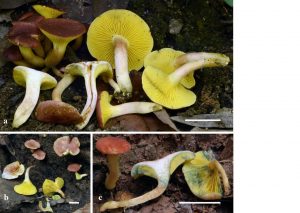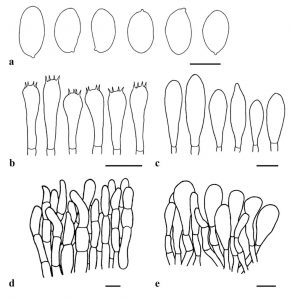Phylloporus attenuatus Hosen, in Hosen & Li, Mycologia 109: 279 (2017)
Index Fungorum number: IF803939; Figs. 87, 88
Basidiomata gregarious to caespitose, small to medium-sized. Pileus 11–62 mm in diam., convex to plano-convex, with age becoming slightly applanate to slightly depressed at center; margin inflexed, uplifted in age; surface dry, even, becoming cracked with age, brown (7E7-8) or brownish orange (7C7–8) to brick red or burnt Sienna (7D7–8) when young, fading with age; context 7–24 mm thick at center, pale yellow (1A3), turning slightly blue when cut. Hymenophore lamellate, subdecurrent to deeply decurrent. Lamellae 11–36 × 3–5 mm, intervenose, sometimes forked, ventricose, subdistant; surface transvenose, smooth, yellow (2A6), rapidly and intensely staining blue when injured, then turning red with time; edge entire, concolorous; lamellulae common, in 1–3 tiers. Stipe 24–44 × 3–10 mm, central, straight or sometimes curved, tapering downwards, sometimes slightly radicant; surface dry, with yellow pruina at the top, then with fine reddish dots mostly down to the lower third, lower part off-white to light greyish yellow (2A4); context solid, pale yellow (1A3), staining slightly blue at upper part when cut or injured, lower part remaining unchanged. Basal mycelium little developed, tomentose, yellow. Odor and taste not distinctive.
Basidiospores [150/3/3] (6.5–)6.6–7.6–8.9(–9.7) × (4–)4–4.4–4.8(–4.9) µm, Q = (1.45–)1.58–1.74–2.19(–2.39), ovoid to ellipsoid, greyish yellow (1B2–4) when observed in H2O and 5% KOH, smooth under light microscope. Basidia 23–36 × 7–10 μm, 4-spored, with sterigmata 3–6 μm long, narrowly clavate to clavate, hyaline to greyish yellow (1B3) in H2O and 5% KOH. Hymenophoral trama 50–110 μm wide, bilateral, composed of cylindrical, hyaline hyphae 8–12 μm diam. Cheilo- and pleurocystidia 43–69 × 13–21 μm, narrowly clavate to clavate, sometime fusoid to narrowly fusoid, hyaline to greyish yellow (1B3) in H2O and 5% KOH. Pileipellis a trichodermium, composed of cylindrical cells, more or less vertically arranged, slightly interwoven, hyaline to greyish yellow (1B3) in H2O and KOH; terminal cells 19–47 × 7–17 μm, cylindrical, subclavate, sometimes attenuated toward the apex. Pileal trama made up of hyaline hyphae 6–14 diam. Stipitipellis an interrupted hymeniderm to trichoderm, hyphae 6–10 μm diam.; caulocystidia 28–54 × 11–19 μm, scattered, clavate, hyaline to greyish yellow (1B3), clay (5D5). Stipe trama composed of cylindrical, hyaline hyphae 6–13 μm diam. Clamp connections not seen in any tissue.
Material examined – Thailand. Chiang Mai Province, Mae On District, N18°51’55”–E99°17’23”, 04/07/12, O. Raspé & K. Wisitrassameewong, OR0382 (MFLU12-0234); —, Muang District, N18°48′-E 98°56′, 06/06/2013, O. Raspé & S. Vadthanarat, OR0536 (CMU-SDBR); —, Mae On District, N18°52’11”-E99°18’23”, 29/06/2014, O. Raspé & B. Thongbai, OR0769 (MFLU14-0471); —, N18°51’57”-E99°17’23”, 01/06/2015, O. Raspé & S. Vadthanarat, OR0914 (CMU-SDBR).
GenBank numbers – ATP6: MT861150 (OR0382), MT861151 (OR0536), MT861152 (OR0914); RPB2: MT861158 (OR0382), MT861159 (OR0536), MT861160 (OR0914); TEF1-α: MT861164 (OR0382), MT861165 (OR0536), MT861166 (OR0914).
Known distribution (based on molecular data) – Bangladesh (Hosen et al. 2017), Thailand (this study).
Known habitat (based on molecular data) – soil in forests dominated by Shorea robusta (Hosen et al. 2017), dry dipterocarp forest.
Notes – Phylloporus attenuatus can be recognized by its brownish-red pileus, somewhat forking, strongly decurrent and intensely and quickly bluing lamellae, and tapering stipe. Macro- and micro-morphology of P. attenuatus specimens from Thailand are identical to the previous description of the specimens from Bangladesh (Hosen et al. 2017). In the mutli-gene tree, P. attenuatus from Thailand also groups with P. attenuatus (holotype, HKAS 76168) from Bangladesh with high support (BS=100% and PP=1). Both morphological and phylogenetic evidence indicate that the Thai specimens studied and the P. attenuatus specimens studied by Hosen et al. (2017) are conspecific.

Fig 1. Basidiomata of Phylloporus attenuatus in the field. a Phylloporus attenuatus (OR0914). b Phylloporus attenuatus (OR0382). c Phylloporus attenuatus (OR0536). Scale bars: a–c = 2 cm.

Fig 2. Microscopic characters of Phylloporus attenuatus (OR0914). a Basidiospores. b Basidia. c Cheilo- and pleurocystidia. d Pileipellis. e Stipitipellis. Scale bars: a = 5 µm, b–e = 20 µm.
